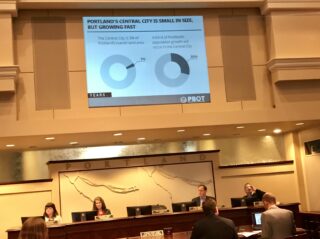
It’s time for Portland to build more efficient streets downtown where walkers and bicycle riders can get around without fearing for their life. And to make it happen, we need to move forward with the Central City in Motion plan and more people need to stop driving cars.
That was the message newly-appointed Transportation Commissioner Chloe Eudaly shared at Thursday’s city council hearing. Commissioner Eudaly made activist hearts flutter when she opened the meeting with a speech that set a strong tone that helped pass the plan with flying colors in a vote of 3-0 (two commissioners were absent). Eudaly’s tone throughout was “Blumenauer-like” one source told me after the meeting, referring to U.S. Congressman Earl Blumenauer, who served as PBOT commissioner in the 1990s when our city put itself on the map as a leader in bicycling, walking, and transit.
Recounting her experience being stuck in Hawthorne Bridge traffic next to a TriMet bus, in her opening speech Eudaly said Portland needs to encourage incentives and disincentives so people, “Change their deeply engrained behaviors and their cherished traditions — namely to not drive their single occupancy vehicles [into downtown].” She also promised that no public funds would be spent on auto parking garages and that the city is current “over-investing” in east Portland, pushing back against any claims that central city investment is not equitable (an issue that has plagued bikeway investments in the past).
Even without Mayor Ted Wheeler in attendance (he’s had a very rough 24 hours) Eudaly urged the council to vote on the plan instead of delaying it, as often happens at first readings of new ordinances. She said it’s already taken six years to get to this point where 18 projects are vetted and ready-to-go. “We need to adopt this plan today,” she said, “to move forward with any of them.”
After a presentation by PBOT staff, other commissioners had the chance to ask questions.
Commissioner Amanda Fritz, known for being a walking advocate, wanted assurances from PBOT that protected bikeways wouldn’t create stressful conditions for people on foot. Fritz also asked why PBOT chose SW Broadway and 4th for the marquee cycling couplet instead of 5th and 6th (a.k.a. the transit mall). It’s likely Fritz asked about this because taking drivers off the transit mall is something the Portland Business Alliance has advocated for (instead of Broadway and 4th).
PBOT Project Manager Gabe Graff was ready for the question.
Advertisement
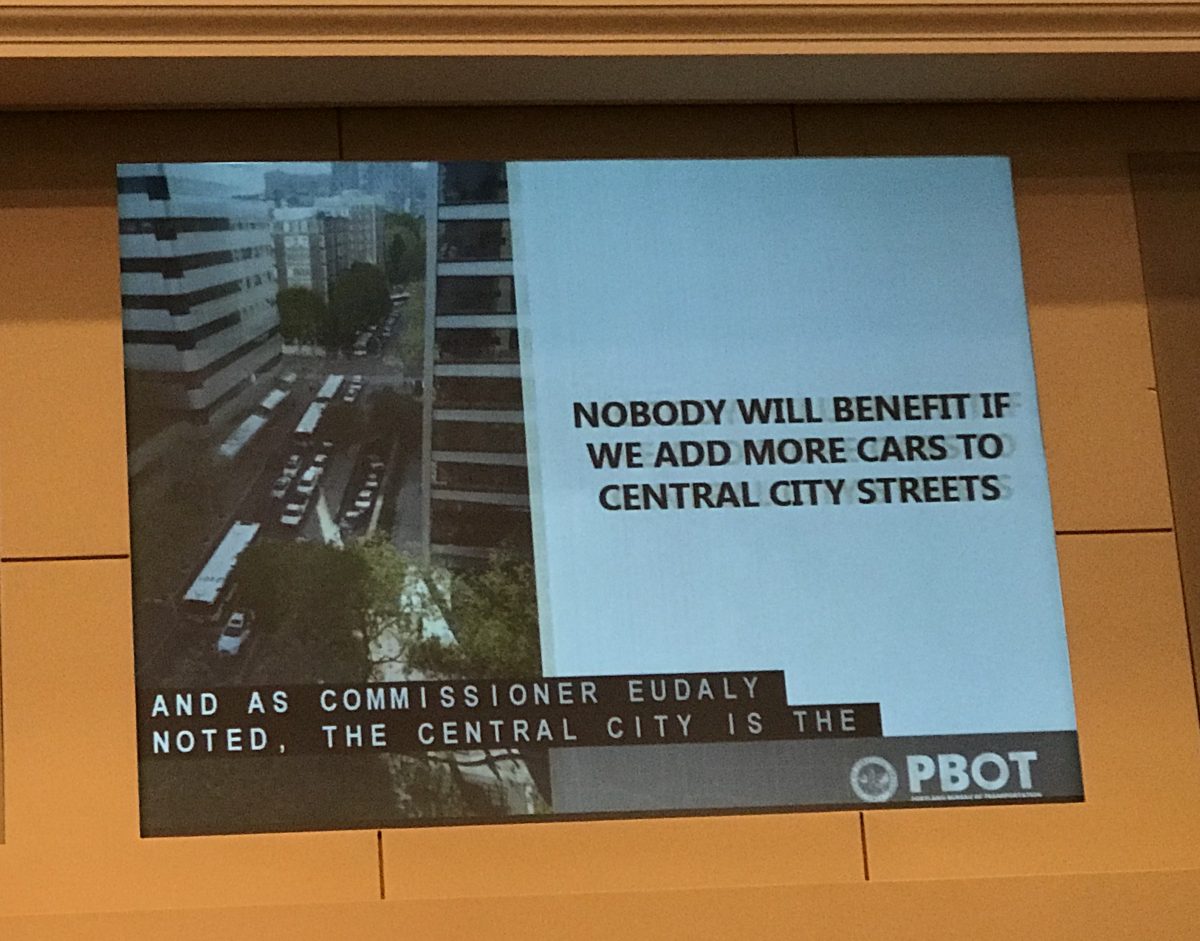
He described engineering challenges like access to major hotels that open onto 5th and 6th and landlocked buildings that use the transit mall for garbage service and other deliveries. “And there are political challenges,” Graff added, “The property owners that paid into the LID [local improvement district] that constructed the [transit] mall were promised continuous vehicular access.” Then Commissioner Fritz interjected, “And we don’t want to break promises.”
“Today we can begin a new era of Portland leadership in green and efficient transportation.”
— Catie Gould, Bike Loud PDX vice-chair
There were several panels of people invited to testify — and most of them echoed Eudaly’s call for action. A TriMet rep said they want the transit priority projects built, “As quick as we can.” Many people pushed for all 18 projects to be completed in the first 1-5 years, if not sooner.
Emily Barrett, a board member for The Street Trust, told stories about how friends won’t bike downtown because it’s unsafe. “I don’t want this to be a brave choice,” she said.
Clint Culpepper, transportation options manager for Portland State University, said a permanent protected bikeway on SW Broadway “is overdue”. He added that they’ve seen student driving rates increase, “Because of the lower level of comfort and safety bicycle riders feel in the central city.”
Bike Loud PDX Vice-chair Catie Gould (who, in a mark of respect for the grassroots group, was invited by PBOT to testify) told council it’s time for Portland to stop resting on its laurels. “Pent up demand for safe and efficient transportation alternatives mean that bold actions can lead to meaningful results,” she said. “Today we can begin a new era of Portland leadership in green and efficient transportation.”
“I like protected bikeways… They’re important to get people like me to ride. I won’t ride because I’m too afraid, and there are a lot of people like that.”
— Commissioner Dan Saltzman
Gary Cobb, community outreach coordinator with Central City Concern, a homeless services organization, said the W Burnside project was especially needed for their clients. “We urge you to move forward with this plan.. With 6,000 low-income patients and 600 residents at our building, that part of Burnside is important for us for safety and mobility.”
When it was time for public testimony, there was strong support for the plan — as well as major concerns from business owners and their advocates. And a rep from PBOT’s own Freight Advisory Committee requested more analysis of trucking impacts.
There was a nearly united front from freight and central eastside business interests that the proposed protected bikeways on NE/SE 7th Avenue should be moved to 6th. PBOT prefers 7th because it’s direct, wide enough to support a quality bikeway, and it connects much better to the rest of the network (including the forthcoming carfree bridge over Sullivan’s Gulch). But reps from the Central Eastside Industrial Council and the PBOT Freight Committee want bikes off 7th and on 6th Avenue instead. With 6th marked as part of the future Green Loop they see think it’s “redundant” to have bikes on both.
There was a clear tension between those who see the central eastside as a current and future “industrial sanctuary” and those who feel the area is changing and needs to be planned for as a residential and retail destination. It seems Commissioner Eudaly and PBOT think it will become more like the Pearl District (Eudaly even referred to it as a “former industrial sanctuary”) and some business reps and Commissioner Fritz believe we need to dig in and preserve it as a heavy industry and manufacturing hub. In the end Fritz proposed an amendment to the ordinance that would “ensure freight and loading zone access for central eastside businesses.” Both Eudaly and PBOT supported it and agreed to continue to work on issues raised.
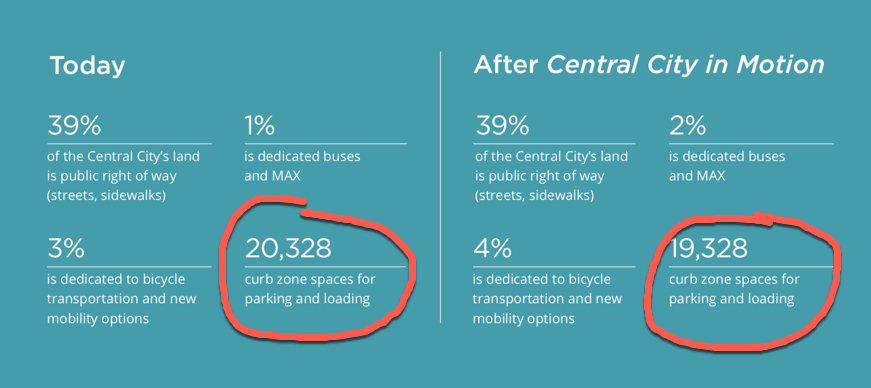
(Graphic: PBOT)
Business representatives from northeast Broadway also expressed concerns over how new protected bike lanes and other changes would impact loading zones and customer access. The owners of Elephant’s Deli and Cotton Cloud futons said they would suffer if the projects were built. The owner of the futon shop on NE 7th and Broadway said, “If these things go through it will impact my business very strongly… we’d probably go out of business.” Elephant’s Deli owner said, “Losing the parking lanes and loading zones would be devastating.”
An employee of Modern Times Beer, located on SE Belmont between 6th and 7th also expressed concerns with the plan. He said their brewery has access doors on both streets and worries they’d be closed off if the project is built. He said he supports the goals of the plan, but that, “We need to ensure our ability to survive won’t be impacted.”
After they spoke and returned to their seats, PBOT Project Manager Gabe Graff walked over and got their contact information — a very smart move that was surely seen by the commissioners.
Rina Jimmerson with the Central Eastside Industrial Council said the loss of 100 on-street parking spots along 7th Avenue would, “Disrupt our parking system.” Jimmerson added that PBOT hasn’t done enough outreach to businesses and that the projects would hurt workers who drive into the central eastside. “We’re not against bikes,” she said, “but this plan needs to remember the low-wage workers.”
After the ebullient start of the hearing, at this point it felt like the tide might be turning against the plan.
Then Jessica Engelman stepped up to the mic. Engelman is a dedicated transportation advocate who volunteers with Bike Loud PDX and lives in the central eastside. She said she signed up to testify late, specifically to respond to concerns that might have popped up. Anyone saying there hasn’t been enough outreach on this plan, “Has been living under a rock,” she said confidently, as she pointed out a list of previously adopted plans that the Central City in Motion plan would fulfill (and which she printed out and gave to the commissioners). When it comes to putting a bikeway on 6th instead of 7th, Engelman warned that would be a big mistake and would lead to the same problem we have now of bicycle riders trying to ride through the Waterfront Park path.
As for concerns from businesses on inner NE Broadway? “I don’t shop there because it’s a terrifying street,” Engelman said, “Maybe if we made it a little less terrifying you’d get more business and you wouldn’t have to close.”
The Street Trust Executive Director Jillian Detweiler took a much different stance with her testimony than other advocates in the room. She appealed directly to commissioners and told them how her organization’s encouragement programs — like Women Bike, the Bike More Challenge, and others — would get people on bikes. “We want to be your partner to ensure that if these projects are built, they will be successful.” (The one-two punch between Bike Loud PDX leaders and volunteers and The Street Trust was really effective.)
With Mayor Wheeler absent and Commissioner Nick Fish having left for some reason during the hearing, and with concerns raises about business and parking impacts, it wasn’t clear that council would vote on the plan last night. But as persuasive testimony in favor of the plan piled up, and PBOT project staff confidently answered every question raised, the remaining three commissioners (which is enough for a quorum) decided the time to pass it was now.
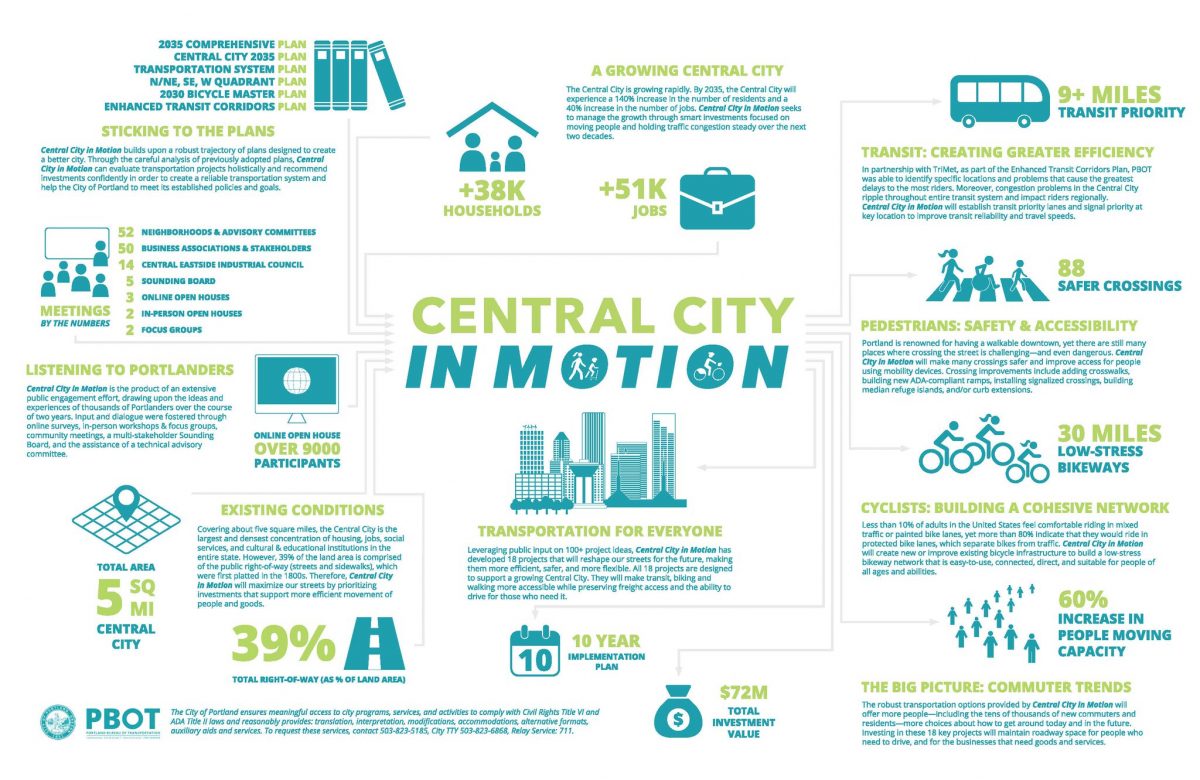
Prior to votes being called, Commissioner Eudaly offered a closing statement that caused several transportation advocates in the room to touch their hands to their hearts. She thanked biking activists for their work (calling several out by name) in making Portland a safer and easier place to ride and said, “For too long we’ve taken care of… car drivers. If it seems like we’re devoting a lot of time and money to walking and biking; we are. And it’s very necessary.” Saying that it’s “imperative” due to climate change, public healthy, safety, equity, and quality of life, Eudaly brushed aside driving concerns. “We can’t please everyone all the time.”
Then she went further, telling a story that cars with engines are relatively new to our streets and that, “For millennia before, streets served multiple purposes.” Citing the Critical Mass motto, Eudaly continued: “We are traffic. I have a motto for people who are single-occupant vehicle drivers frustrated while sitting in traffic. You are the congestion!”
After she voted “Aye,” Fritz and Saltzman gave their closing statements.
Fritz said the plan is “very important” and called herself a, “Huge pedestrian and transit advocate.” Then she added, while she herself doesn’t like to bike, because her son and his wife ride, “I’m also an avid cycling advocate.” She voted “Aye.”
And Saltzman, with just a few months left in his long tenure as a city commissioner, said, “I like protected bikeways a lot. They’re important to get people like me to ride. I won’t ride because I’m too afraid, and there are a lot of people like that… If we’re going to be successful to get our bicycling rates up, we need to overcome that.” He voted, “Aye.”
And the resolution passed. And there was much rejoicing — not just from the advocates in the room; but from the commissioners themselves, who, even after a long day seemed to appreciate a civil and productive meeting where something of great importance to our city moved forward with widespread support.
Great job everyone! This is a massive step forward for Portland.
Here’s a photo from Kiel Johnson after the meeting that shows just a small part of the dedicated advocates who worked to make this happen:
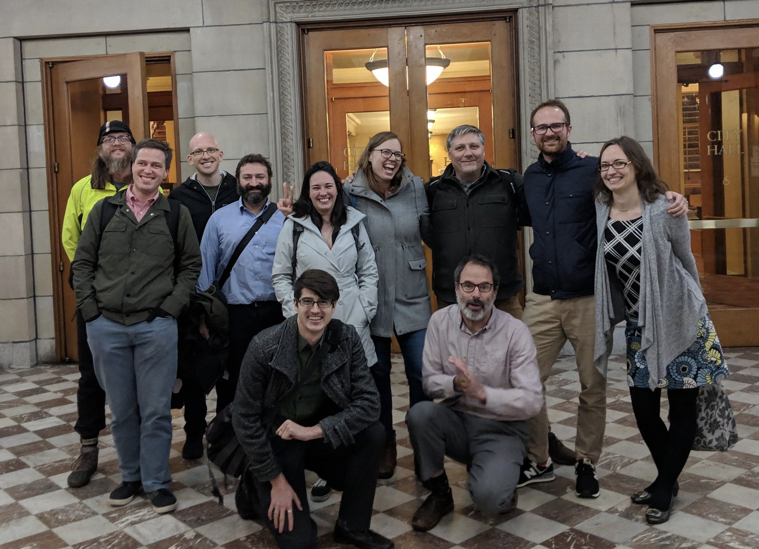
(Photo courtesy Kiel Johnson)
Helpful links for more info:
– Don’t miss our live-tweeting coverage thread which you can read here.
– Central City in Motion official city website.
– Central City in Motion Implementation Plan (PDF, 27 MB)
– Interactive map of all 18 projects.
– About funding: Of the $35 million needed to build the first phase projects, PBOT has: $8.3 million secured (federal grant and local gas tax); $16.7 million highly likely from TriMet ($5.5M) and System Development Charges ($11M). There’s still a $10 million or so gap to fill; but when you’ve got this much momentum and legwork done on a set of shovel-ready projects, money has a way of magically appearing. That said, we’ll need to fight hard to get more money to build this stuff.
UPDATE, 11/16 at 4:51 pm: The Willamette Week reports that both Mayor Wheeler and Commissioner Fish would have voted yes on the plan.
— Jonathan Maus: (503) 706-8804, @jonathan_maus on Twitter and jonathan@bikeportland.org
Never miss a story. Sign-up for the daily BP Headlines email.
BikePortland needs your support.



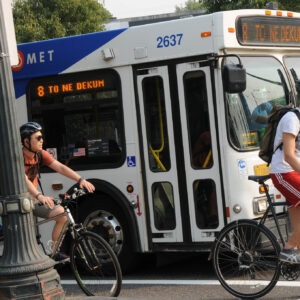
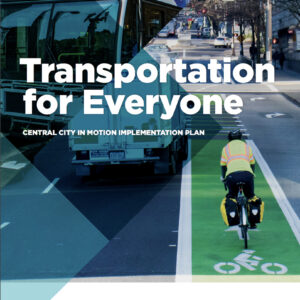

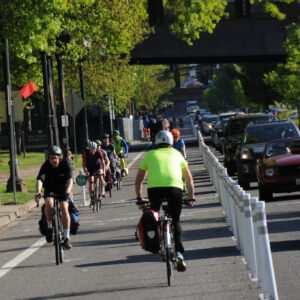
Thanks for reading.
BikePortland has served this community with independent community journalism since 2005. We rely on subscriptions from readers like you to survive. Your financial support is vital in keeping this valuable resource alive and well.
Please subscribe today to strengthen and expand our work.
> With Mayor Wheeler absent and Commissioner Nick Fish having left for some reason during the hearing, there were only three commissioners left for the final vote. …
> Eudaly, Fritz and Saltzman voted in favor of the plan.
Wheeler’s had a few mis-steps lately – not opposing the I-5 expansion, the Muttergate incident, and now skipping the final vote on a major city plan – it seems he has literally created a power vacuum, which Eudaly is handily filling.
Wheeler is burned out and wants out. Can’t much blame him. Portland had become unmanageable and ungovernable.
Can’t wait for the BikePortland article 5 years from now asking why none of the CCIM projects have been built, despite a robust plan to do so, and the comments equating this to the 2030 Bike Plan which sits on a shelf collecting dust. Eudaly mentioned modelling this plan after the corresponding East Portland one. If that’s the case, then we can expect PBOT to sit on the funds for ten years without building anything, just as they have done in East Portland.
Hi Peter,
This is very different than the 2030 Bike Plan. While all the projects aren’t funded, there is $8 million in the bank and another $16 million that’s ours for the taking. Despite what the haters and the local media wanted everyone to believe back in 2009, the bike plan had ZERO dedicated funds.
The Bike Plan was also mostly about policy, not projects. The projects in the Bike Plan are only listed in an appendix – without any detail. By contrast, projects in this plan are real. They are more than lines on a map, they have been given an initial scoping and engineering and PBOT has 2 yrs of outreach and feedback around them. In other words… We have money and momentum and a hot list of vetted projects that just got a green light from council.
If we don’t get these built relatively quickly, PBOT and the commissioners will have hell to pay.
Cliff also mention the East Portland In Motion Plan (EPIM) and, to the best of my knowledge, we have yet to see a single high-priority bike project on the EPIM list be completed* despite the fact that some were funded over 6 years ago.
*one third of the 100s Neighborhood Greenway was built (to older standards) and then build out of came to a halt for ~5 years.
Also keep in mind, per East Portland, that any money allocated today for CCIM can be re-allocated tomorrow towards the next shiny new transportation initiative. None of the CCIM money is “dedicated” any more than PBOT EPIM money was dedicated. The city has delayed projects that had “dedicated funds” for up to 20 years (for the Cully project), while the Gibbs Street bridge was approved 48 years before it was built.
I’m speculating that CCIM will next be rededicated towards the May 2020 Portland Driverless Shared Vehicle PDSV (RoboCar) program that Nick Fish will suddenly envision next March.
And more recently, Novick and Hales cancelled the 100s and 4M Neighborhood Greenway and used this “dedicated EPIM funding” to fix potholes and pave streets in inner Portland.
True story, but the 4M never had any dedicated funding. We bike advocates in East Portland tried to get MTIP funds for it in 2013 and 14 (twice), but were overruled by others in EPAP who honestly believed that PBOT would build it anyway “because it was the right thing to do.” They instead pushed for more money for Powell. The same EPAP leadership later regretted their decision to not push for dedicated MTIP funding for 4M.
The 100s route was a Roger Geller project that never had a lot of support from EPAP bike advocates; we thought the 4M, 130s and 150s were much more important, as well as buffered bike lanes on Division. We had grouped the 100s with the HOP, Sacramento, and Neageli projects as the next most important, after the first 4 were done. And we never discussed protected bike lanes at all until after EPIM was adopted in 2012 – we had essentially abandoned 122nd, Stark, Glisan, and Foster to cars and fearless cyclists. How times change.
If you or anyone else are really serious about improving East Portland bicycling, I can still connect you with some of the past advocates out there.
As I recall 4M was supposed to be built with PBOT active transportation funding (which at one time was a couple of million a year). Of course, in those days Neighborhood Greenways were built to different standards so were a lot cheaper per mile.
Below is the project list for East Portland. I encourage you to get involved. Like you, I hope we don’t just get to see more renderings in the Central City, East or SW. I have to suspect the coffers have been filling with the Fixing Our Streets tax revenue, so feel less skeptical now than in the past.
122nd Ave Plan: Safety, Access and Transit
East Glisan Street Update
Gateway to Opportunity
East Portland Active Transportation to Transit Project
Halsey-Weidler Streetscape Project
EPASS: East Portland Arterial Streets Strategy
SE 122nd Ave Bridge Over Johnson Creek
HOP Neighborhood Greenway: Gateway Transit Center to NE 128th Avenue
Outer Halsey Safety Project
East Portland Access to Employment & Education
East Portland Rapid Flash Beacon Project
4M Bikeway: SE 130th Avenue to SE 174th Avenue
122nd Avenue Area Safety Improvements
NE 102nd Avenue: Sandy Boulevard to I-84
NE Halsey: 102nd to Weidler
Safety Action Plan for Outer SE Division Street
SE 104th Ave & SE Holgate Blvd Signal Rebuilds
SE 112th Avenue: Market Street to Powell Boulevard
SE 136th Sidewalks to Opportunity
SE Flavel Street: 84th to 92nd Avenue
I’m going to wait a few years before I voice criticisms over the slow pace of CCIM implementation. It’s my hope that PBOT’s admitted embarrassment over the inexcuseably slow pace of implementation of EPIM (and other projects) will lead to reforms. However, I will note that your list fails to include high priority EPIM projects that were *funded* 7 years ago and have still yet to be built (the 130 and 100 Neighborhood Greenwaya, for example). In fact, quite a few high priority EPIM projects are still waiting for the design phase to be completed despite have been funded for so many years ago.
You left out the $50 million Foster Elevated Roadway project. I’m not kidding, it’s really in there. So is an unfunded bike/ped bridge crossing I-84 at 132nd. Plus the $110 million for rebuilding outer Powell Blvd which the state approved.
That’s a fine list for EPIM. I do wish there were also low hanging fruit “missing connections” in place for the eventual Master Bicycle Plan build out. For example, 82nd to 92nd wayfinding signs on SE Tolman with an eventual, enhanced crossing at 82nd and continuation of the 92nd Ave bike lanes through the Lents Town Center and past Zoiglhaus to connect with the Ellis “greenway”. Aye, may it come in the next round and hopefully before another 10 years are gone!
Other East Portland missing links:
– NE Fremont, 145th to 148th (a rare greenfield about to be developed)
– NE I84 MUP, 102nd to 122nd (assuming the camping issues on the I205 MUP get resolved)
– NE I84 underpasses at 122nd, 148th, 162nd, overpass at 102nd
– NE 155th between Halsey and Summerplace
– NE Holladay between 155th and 157th
– DC8 crash site memorial at NE 157th & Everett
– MUP through Lynch Elementary at 169th, for an eventual 170s greenway
– NE 106th from Halsey to San Rafael
– Use of the existing bike bridge over I-84 between 102nd and 105th
– NE 112th bike bridges over the Columbia Slough (2 small bridges)
Woo hoo!!! Let’s get building! I’m all for build the whole thing at once on the cheap, get feedback, work with stakeholders, etc. along the way. Make the highest priority projects permanent first. Everyone benefits. EVERYONE.
…except maybe the poor schmucks in East Portland trying to bike to their jobs on the Columbia Corridor?
Hey come on now, Eudaly did come out to NE 122nd for a photo op. That’s something! ; )
I’m so glad this passed, with unanimous support and no major amendments. Commissioner Eudaly’s opening and closing remarks were fantastic, and they bode really well for the future of PBOT while she’s Commissioner in Charge.
Exceedingly happy this passed. We have so much work to do, and obviously this only targets the central city, but what a wonderful change this will bring. Thanks to the commissioners for showing up and voting and thanks for covering the meeting!
Looks like things might be going in the right direction. This is only the beginning. The good stuff will start to happen in about 10 years if things go along this trajectory.
When do we begin?
As soon as the 2030 bike plan starts getting implemented…
Which should be any century now…
Great news! I will say I am among those who does not want to change the central eastside into another Pearl; having a light industrial area in the heart of our city is a great thing.
Looking forward to our new bike projects!
Just for the record, if you read a version of this post prior to 9:10 am Friday morning 11/18 you read an unpolished and unfinished version. It should be much more complete now. And have fewer typos! Thanks for reading and commenting.
I am personally very excited of course! And will share another post with analysis about what happened last night. Watch for that later today.
This sounds great! Though I personally am not totally sure what has been passed.
Does this mean that all the projects on the list are CCIM locked in? Or is this just a resolution to continue planning? Are there more opportunities for opponents to effect changes. Also, what is the funding status?
I appreciate anyone who can shed some light on what happens next!
Sorry that wasn’t more clear Pete.
With the passage of this plan, PBOT has full green light to move forward on the first phase of projects in the plan. With $35 million in their pockets, this is real. This is not a drill. They will start immediately scoping, engineering, designing, refining the projects in the list below and construction could very likely start next year.
Are the projects “locked in”? Yes and no. It’s not a set-in-stone list because PBOT will surely be able to switch things around as necessary. There’s a lot of work left to do. Some engineering snafus could happen, opposition could happen, and so on. But having the ordinance and the funding and the 2 years of process/outreach legwork done and dusted.. PBOT has marching orders and they are eager to get stuff on the ground.
That’s just a list of costs. Where does it say PBOT actually has this money? As I understand it, a good portion of this funds is coming from TriMet, which of course, will not be building bike infrastructure with the money.
Jonathan, PBOT doesn’t have the 35M. They only have $8M for CCIM. From the official plan:
I know that Belky. Thanks. But PBOT has been using the $35 Million figure because they have very high confidence that it will materialize. TriMet is a very reliable partner and they will give PBOT the money. Transportation SDCs are very reliable and will come in. This thing will attract more money as it becomes more real… That’s another reason why the huge support last night is so important.
But yes, saying “There’s $35 million” isn’t accurate or advisable. There could be more fights to come.
And FWIW Wheeler and Fish would likely have voted yes IMO.
Here is the list of SDC eligible projects, which has already been adopted by Council:
https://www.portlandoregon.gov/transportation/article/676995
There is $20 million allocated to Central City in Motion, and there are numerous other related projects that are also SDC eligible, such as “Central City Portals Transit Enhancements” which is eligible for $5 million or “SW 4th Ave Corridor Improvements ” which is eligible for $2.5 million.
PBOT hasn’t chosen to spend all that the money it’s allowed to, likely because it doesn’t have it all in hand yet. But I think we can be confident that if they’re saying that they’ll spend ~$11.2 million of the SDCs that they’re allowed to, they have every intention of doing so.
The funding TSDC eligibility list is just a wish list. There is no guarantee that TSDCs will be used for any of those individual projects.
And nothing illustrates this better than the totals at the bottom:
Total Project Costs: $4.549 Billion
Already Budgeted: $62.2 Million
TSDC eligible percentage: $589.3 Million
Of that $4.549 billion, $3.5 billion is taken up by just four projects where PBOT isn’t the lead agency: I-5 Rose Quarter; Division Transit Project; SW Corridor; and the Burnside Bridge replacement.
My point is that Council has already passed a list of SDC eligible projects, and Central City in Motion is eligible for a more than has been allocated to date. There’s no reason to believe that the ~$11.2 million won’t be allocated. PBOT has been receiving a lot of SDC revenue over the past few years.
“There’s no reason to believe that the ~$11.2 million won’t be allocated. PBOT has been receiving a lot of SDC revenue over the past few years.”
I very much hope that the $11.2 million is allocated to CCIM. Nevertheless, based on the history of similar plans there are reasons to be cautious about how solid these committments are.
That $11.2 million in TSDC money will be allocated to projects on the TSDC list, but not necessarily to projects downtown – it can be spent anywhere within the city. That decision depends on City Council, and since Saltzman will be out and Hardesty will be in, who knows where in the city the money will go when it gets spent.
Nothing is a “done deal” until it is in the ground and built.
The City Council has already adopted the SDC list for 2017-2027. PBOT needs City Council authority to change the projects on the list, but they don’t need council authority to allocate funds to projects already on the list.
True, but PBOT does need Council approval on their annual budget, which amounts to Council veto on anything PBOT wants to fund and how they go about doing it.
Thanks Jonathan!
Very helpful, as always.
It’s a plan, that’s all. PBOT has yet to secure funding for the vast majority of projects. Some are explicitly coming from TriMet funds as well, so no bike projects will be built from that.
I believe there’s around $30 million in funding for the first bucket of projects (the 1-5 year list). And it sounds like the alignments are pretty well set now. For example, it would be much harder to scrap NW/SW Broadway and exchange it for 9th Ave. so I’d expect that the lines we see on CCIM’s maps to stay as they are. What’s not worked out yet are the exact project details within each line (eg. what exactly the bike lanes will look like, materials, etc). It’s worth noting too that unlike other planning efforts where a plan would pass and that would open the door to go after more funding (leaving a multi year gap between planning and construction), there is money on the table to begin rolling straight into design.
This is just a plan and I’m not sure if any of the projects are fully-funded yet (perhaps someone can correct me on this). PBOT will likely wait for full funding to materialize before they negotiate IGAs and start the design phase in earnest. In the past PBOT has taken 6-9 years to start building similar projects once they are fully funded. And, yes, all of the individual projects will go through a design process, will require more outreach, and will hopefully not have to be redesigned or delayed due to public input.
Correction: some of the Neighborhood Greenway improvements on this list might happen more quickly…PBOT generally completes those projects in 2-3 years.
In general, PBOT will design projects for inner Portland long before they have any inkling of project funding, but for projects in outer Portland, they will wait several years after funding has been approved to design anything.
It’s not unanimous is 2/5 of the council wasn’t there. It was unanimous amongst the councilors that WERE present, but “unanimous” alone makes it sound like the entire council was on board.
In any case, GOOD JOB to those councilors who were there and got this passed!
I am so thrilled that this passed with such strong support! Many thanks to all the advocates who gave hours of detailed feedback, the PBOT staff for putting together a strong plan, and the commissioners for voting yes, especially Commissioner Eudaly for being such a champion. I’m looking forward to seeing the plan start to become reality in the next phase!
Congrats everyone for your hard work to get this passed! Can’t wait to see these projects get built. Thanks to everyone who helped, Jonathan Maus, BikeLoudPDX, Comrade Eudaly, The Street Strust, and others. See you soon in the new bike lanes!!
Everyone needs to stop what they’re doing and send Commissioner Eudaly an email or call to thank her for the amazing rhetoric and support at yesterday’s meeting. That was, in many ways, just as big a development as CCIM passing council.
I’m trying to figure out what in the world the owner of Cotton Cloud has to complain about with this plan, and I must be missing it – from what I can see, neither of the projects near Cotton Cloud would make any changes to the parking/loading zones in front of their store. Project #3 doesn’t make any changes at all to their stretch of 7th, and project #18 starts the protected bike lane past their storefront. To top it off, they also have their own parking lot which would be unaffected.
How does making zero changes to their parking and loading areas equate to them going out of business? Are they primarily depending on drivers seeing their store while driving past it and impulse-buying a futon?
It is counter to the owner’s world view. It has nothing to do with actual business.
How do you know what this business needs better than the owners?
I was more suggesting that this business owner was interpreting the projects as containing changes that weren’t actually in the plans, and WOULD hurt their business (like if a protected bike lane replaced their only loading or parking zone).
There is literally zero parking reduction in the current plans that intersect the Lloyd District, and project #18 adds some parking. The owner is either unaware of that, or yes – allowing their worldview to take precedence over their own business needs, and being hyperbolic about it.
Maybe they’ll sleep on it?
In the wake of the bike tax and other awfulness of HB 2017, this comes as such a relief! It sounds like Portland still has some progressive mojo, even if the state as a whole is backsliding. Glad I’m living here and looking forward to implementation!
This is great news, there a ton of really great projects on this list. I hope they build them quickly and completely; PBOT too often leaves dangerous gaps or fails connect projects. I think we could have a surge in bike ridership if PBOT would focus more on improving the network instead of individual segments. Granted, a num,ber of these of these projects will do exactly that, so, yeah! I am surprised by the insistence of SE 7th over SE 6th. I have worked in the CEID since 2008 and commuted through it by bike the whole time. I think 6th, with diverters and real greenway treatment, could be much more direct and pleasant route for biking. There are fewer driveways, the grade is gentler, and it avoids the very sketchy connection with Sandy. 6th also splits the difference between destination on 7th and MLK/Grand . The route from SE Division to NE Everett is very direct. IMO, the number of businesses with driveways and loading on 7th, the steeper hill, and the terrible intersection with Sandy make 7th a poor choice. However, 7th does have some existing traffic signals that could create safer intersections. As long as the City doesn’t build a contra-flow protected MUP-style bike lane on the east side of 7th- that would be insane!
UPDATE, 11/16 at 4:51 pm: The Willamette Week reports that both Mayor Wheeler and Commissioner Fish would have voted yes on the plan.
We shall see. While shadow mayor of the hills fritz voted yes, we shall see how she actually supports or doesn’t support. The Oregonian has not really come out in support and if you read the comments, not everyone is thrilled they are being further cutoff from their car crack habit.
Portland has been here before and failed.
What has the Oregonian have to do with it? It’s little more than a right-wing rag these days.
A lot of blue hairs, aka people who vote in good numbers, read the Oregonian religiously. So yeah, the Oregonian is a big deal.
Please refrain from using pejorative labels for people who are different than you.
Well, it would be great if the two no shows would actually organize a formal vote so there is a record of their vote. What would it hurt?
Oh, you are so precious. See…this is what people love snowflakes. You know kitty, there really are derogatory words out there which should be said. But you know, the 451 police haven’t been by yet to ban that word. Don’t worry, I am sure they are just around the corner. But for you, because you are precious, I will change the word to senior citizens.
Feel better?